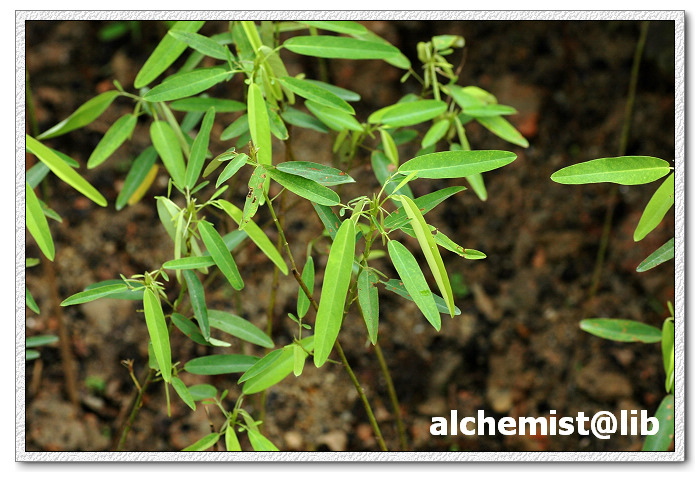- Scientific Name: Codariocalyx motorius (Houtt.) H.Ohashi
- Ref: J. Jap. Bot. 40:367. 1965
- Synonyms: Codariocalyx gyrans (L.f.) Hassk.; Desmodium gyrans (L.f.) DC.; D. motorium (Houtt.) Merr.; D. roylei Wight & Arn.; Hedysarum gyrans L.f.; H. motorium Houtt.; H. saliens Salisb.; Meibomia gyrans (L.f.) Kuntze; Pseudarthria gyrans (L.f.) Hassk.
- English Common Name: telegraph plant, dancing plant, semaphore plant
- Chinese Common Name: 舞草 wǔcǎo, 跳舞草 tiàowǔ∙cǎo, 钟萼豆 zhōng’è∙dòu
- Family: Fabaceae
- Genus: Codariocalyx
- Distribution: Mountain slopes, thickets; 200-1500 m. Fujian, Guangdong, Guangxi, Guizhou, Jiangxi, Sichuan, Taiwan, Xizang, Yunnan [Bhutan, Cambodia, India, Indonesia, Laos, Malaysia, Myanmar, Nepal, Philippines, Sri Lanka, Thailand, Vietnam].
- Photo: 06/21/2009, South China Botanical Garden, Guangdong
- Note: FOC uses the orth. var. genus name Codoriocalyx
Shrubs, to 1.5 m tall. Stem simple or branched, glabrous. Leaves 3-foliolate, often 1-foliolate by reduction of lateral leaflets; petiole 1.1-2 cm; terminal leaflet blade narrowly elliptic or lanceolate, 5.5-10 × 1-2.5 cm, abaxially appressed pubescent, adaxially glabrous; lateral ones when present narrowly elliptic or linear, very small. Panicles or racemes; rachis with reflexed uncinate and straight rigid hairs. Pedicel 1-4 mm at anthesis, 3-7 mm in fruit. Calyx 2-2.5 mm; tube 1-1.5 mm; lower lobe dentate, upper lobe deeply 2-toothed at apex. Corolla purplish red; standard 7.5-10 × 7.5-10 mm; wings 6.5-9.5 × 4-5 mm; keel 9-10 × ca. 3 mm, long clawed. Stamens 8-11 mm. Gynoecium 1-1.2 cm; ovary puberulent. Legume falcate or straight, with sparse short hooked hairs, dehiscent along lower suture when mature. Seeds 4-4.5 × 2.5-3 mm. Fl. Jul-Sep, fr. Oct-Nov. 2n = 22. (Flora of China)
